Neuroprediction of violence and criminal behavior using neuro-imaging data: From innovation to considerations for future directions
IF 3.4
2区 心理学
Q1 CRIMINOLOGY & PENOLOGY
引用次数: 0
Abstract
Violent conduct in society is a major health concern, and therefore one of the major aims in forensic mental healthcare is the assessment of the risk for (future) violence. The prediction of violence risk is traditionally done by using violence risk assessment tools in the form of actuarial instruments and structured professional judgments. However, research has shown that the risk assessment tools that are currently being used, are not as accurate in predicting future risk as one would hope for. Therefore, some scholars advocate a paradigm shift by incorporating a biopsychosocial model, including neurobiological measures in risk assessment models. The current review aimed to give answer to the question whether neuro-imaging measurements add in the accuracy of predicting aggression and violent (criminal) recidivism, and to discuss what next steps need to be taken to move neuro-imaging informed risk assessment forward in forensic clinical practice. The results of the current review showed that findings regarding ‘neuroprediction’ are mainly based on cross-sectional studies and that studies using rigorous methods for determining the incremental predictive accuracy of neural parameters are lacking. Future studies need to rely on prospective and longitudinal data that address the added value of neural measures over traditional risk factors specifically, taken different ethical and judicial considerations into account. Studies that take a personalized approach, focusing on neurobiologically informed risk assessment at the individual level to translate this into forensic clinical practice, is in our view the next step that will move this forward.
使用神经成像数据对暴力和犯罪行为进行神经预测:从创新到对未来方向的考虑
社会中的暴力行为是一个主要的健康问题,因此法医心理保健的主要目标之一是评估(未来)暴力的风险。暴力风险的预测传统上是通过使用精算工具和结构化专业判断形式的暴力风险评估工具来完成的。然而,研究表明,目前使用的风险评估工具在预测未来风险方面并不像人们希望的那样准确。因此,一些学者主张在风险评估模型中加入生物-心理-社会模型,包括神经生物学测量,从而进行范式转换。当前的综述旨在回答神经成像测量是否增加了预测攻击性和暴力(犯罪)累犯的准确性,并讨论下一步需要采取哪些措施将神经成像信息风险评估推进法医临床实践。当前综述的结果表明,关于“神经预测”的发现主要基于横断面研究,并且缺乏使用严格方法确定神经参数增量预测准确性的研究。未来的研究需要依赖于前瞻性和纵向数据,以解决神经措施对传统风险因素的附加价值,并考虑到不同的伦理和司法因素。在我们看来,采取个性化方法的研究,专注于个人层面的神经生物学风险评估,将其转化为法医临床实践,是推动这一进程的下一步。
本文章由计算机程序翻译,如有差异,请以英文原文为准。
求助全文
约1分钟内获得全文
求助全文
来源期刊

Aggression and Violent Behavior
Multiple-
CiteScore
7.50
自引率
4.30%
发文量
63
期刊介绍:
Aggression and Violent Behavior, A Review Journal is a multidisciplinary journal that publishes substantive and integrative reviews, as well as summary reports of innovative ongoing clinical research programs on a wide range of topics germane to the field of aggression and violent behavior. Papers encompass a large variety of issues, populations, and domains, including homicide (serial, spree, and mass murder: sexual homicide), sexual deviance and assault (rape, serial rape, child molestation, paraphilias), child and youth violence (firesetting, gang violence, juvenile sexual offending), family violence (child physical and sexual abuse, child neglect, incest, spouse and elder abuse), genetic predispositions, and the physiological basis of aggression.
 求助内容:
求助内容: 应助结果提醒方式:
应助结果提醒方式:


